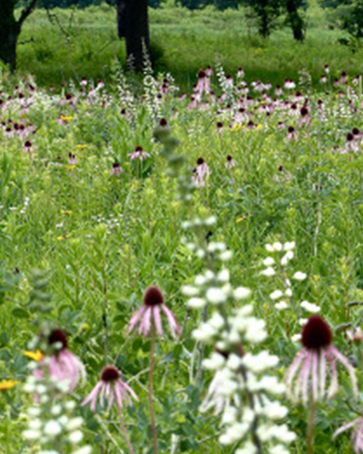Micro Prairie Seed Mix

This seed mix contains both native grasses and forbs that grow best in full sun and medium to dry soil.
Establishing a Micro Prairie
1. Clear site of all vegetation in spring and fall using: herbicide, mowing/burning, shallow tilling and/or smothering with tarp
2. Plant seeds October through March. You’ll want to mix seeds with filler material like sand or sawdust. (This allows a better spread of the seeds) and then broadcast seeds onto site
3. The first year of growth, mow the area to six inches tall
4. The second year you will have a prairie!
What’s in the Prairie Mix?
- Sand Dropseed (Sporobolus cryptandrus)
- Little Bluestem (Schizachyrium scoparium)
- Fox Sedge (Carex vulpinoidea)
- Sideoats Grama (Bouteloua curtipendula)
- Switch Grass (Panicum virgatum)
- Black-eyed Susan (Rudbeckia hirta)
- Common Evening Primrose (Oenothera biennis)
- Slender Mountain Mint (Pycnanthemum tenuifolium)
- Lanceleaf Coreopsis (Coreopsis lanceolata)
- White Prairie Clover (Dalea candida)
- Prairie Cinquefoil (Potentilla arguta)
- Wild Bergamot (Monarda fistulosa)
- Lavender Hyssop (Agastache foeniculum)
- Foxglove Beardtongue (Penstemon digitalis)
- Field Goldenrod (Solidago nemoralis)
- Maximilian’s Sunflower (Helianthus maximiliani)
- Gray-headed Coneflower (Ratibida pinnata)
- Illinois Bundleflower (Desmanthus illinoensis)
- Purple Prairie Clover (Dalea purpurea)
- Canadian Milkvetch (Astragalus canadensis)
- Calico Aster (Symphyotrichum lateriflorum)
- Hoary Vervain (Verbena stricta)
- Partridge Pea (Chamaecrista fasciculata)
- Purple Coneflower (Echinacea purpurea)
- New England Aster (Symphyotrichum novae-angliae)
- Common Milkweed (Asclepias syriaca)
- Butterfly Milkweed (Asclepias tuberosa)
- Frost Aster (Symphyotrichum pilosum)
- Brown-eyed Susan (Rudbeckia triloba)